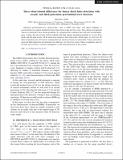Three observational differences for binary black holes detections with second- and third-generation gravitational-wave detectors
Author(s)
Vitale, Salvatore
DownloadPhysRevD.94.121501.pdf (382.3Kb)
PUBLISHER_POLICY
Publisher Policy
Article is made available in accordance with the publisher's policy and may be subject to US copyright law. Please refer to the publisher's site for terms of use.
Terms of use
Metadata
Show full item recordAbstract
Advanced gravitational-wave observatories, such as LIGO and Virgo, will detect hundreds of gravitational-wave signals emitted by binary black holes in the next few years. The collection of detected sources is expected to have certain properties. It is expected that a selection bias will exist toward higher-mass systems, that most events will be oriented with their angular momentum pointing to or away from Earth, and that quiet events will be much more numerous than loud events. In this paper, we show how all these assumptions are only true for existing detectors and do not have any universality. Using a network of proposed third-generation gravitational-wave detectors, we show how each of these assumptions must be revised, and we discuss several consequences on the characterization of the sources.
Date issued
2016-12Department
Massachusetts Institute of Technology. Department of PhysicsJournal
Physical Review D
Publisher
American Physical Society
Citation
Vitale, Salvatore. “Three Observational Differences for Binary Black Holes Detections with Second- and Third-Generation Gravitational-Wave Detectors.” Physical Review D 94.12 (2016): n. pag. © 2016 American Physical Society
Version: Final published version
ISSN
1550-7998
1550-2368